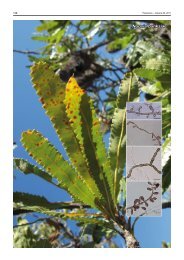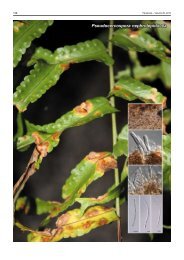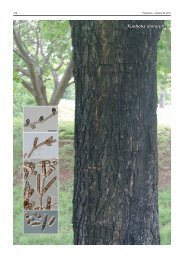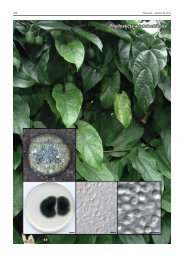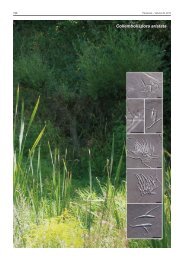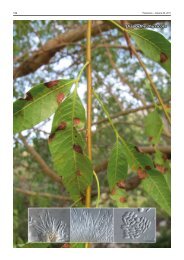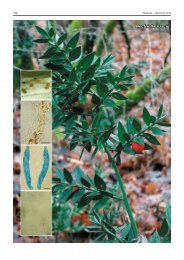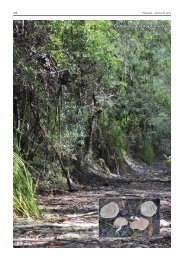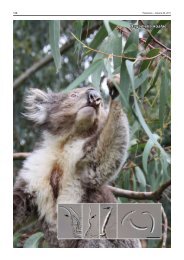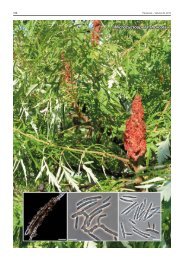Seiridium banksiae - Fungal Planet
Seiridium banksiae - Fungal Planet
Seiridium banksiae - Fungal Planet
You also want an ePaper? Increase the reach of your titles
YUMPU automatically turns print PDFs into web optimized ePapers that Google loves.
136 Persoonia – Volume 27, 2011<br />
<strong>Seiridium</strong> <strong>banksiae</strong>
<strong>Fungal</strong> <strong>Planet</strong> description sheets<br />
137<br />
<strong>Fungal</strong> <strong>Planet</strong> 94 – 6 December 2011<br />
<strong>Seiridium</strong> <strong>banksiae</strong> Crous & Summerell, sp. nov.<br />
Seiridii cardinalis simile, sed conidiis majoribus, (24–)27–30(–35) × (11–)12–<br />
13(–14) µm, discernitur.<br />
Etymology. Named after the host from which it was isolated, Banksia<br />
marginata.<br />
Leaf spots amphigenous, circular to subcircular, medium brown<br />
on upper surface, with grey central region and black conidiomata;<br />
lower surface dirty white due to leaf hairs. Conidiomata<br />
stromatic, acervular, amphigenous, intraepidermal, oval to<br />
ellipsoid, up to 200 µm diam; wall of textura angularis. Conidiophores<br />
lining the basal cavity, hyaline, smooth, subcylindrical,<br />
0–2-septate, unbranched, or branched below, 10–20 ×<br />
5–8 µm. Conidiogenous cells discrete, subcylindrical, hyaline,<br />
smooth, 10–15 × 3–4 µm, with minute apical periclinal thickening,<br />
proliferating 1–2 times percurrently. Conidia fusiform,<br />
straight to slightly curved, (24–)27–30(–35) × (11–)12–13(–14)<br />
µm, 3-distoseptate with visible septal pores, medium brown,<br />
verruculose, thick-walled; apical cell attenuated towards apex;<br />
basal cell lacking appendage, truncate, 3–4 µm diam, at times<br />
with minute marginal frill.<br />
Culture characteristics — (in the dark, 25 °C, after 2 wk):<br />
Colonies flat, spreading, with sparse aerial mycelium and<br />
feathery, lobate margin; reaching 60 mm diam after 2 wk. On<br />
all media mouse-grey in centre, dirty white in outer region..<br />
Typus. Australia, Tasmania, Crescent Bay, S 43°11'29.7" E 147°51'00.7"<br />
on leaves of Banksia marginata (Proteaceae), 14 Oct. 2006, B.A. Summerell<br />
& P. Summerell, holotype CBS H-20756, cultures ex-type CPC 13637 = CBS<br />
131308, ITS sequence GenBank JQ044422 and LSU sequence GenBank<br />
JQ044442, MycoBank MB560698.<br />
Notes — Although Crous et al. (2004) recorded some <strong>Seiridium</strong><br />
spp. from Proteaceae, the first taxon described from this<br />
family was S. proteae (Marincowitz et al. 2008). <strong>Seiridium</strong> <strong>banksiae</strong><br />
is rather distinct from S. proteae and the taxa treated by<br />
Sutton (1980) and Nag Raj (1993) based on its 3-septate conidia<br />
with attenuated apical cells, and conidial dimensions. A megablast<br />
search of the NCBIs GenBank nucleotide sequence database<br />
using the ITS sequence of S. <strong>banksiae</strong> retrieves as closest<br />
hits Discostroma fuscellum (Xylariales, Amphisphaeriaceae;<br />
GenBank JF320818; Identities = 538/569 (95 %), Gaps = 8/569<br />
(1 %)) and Seimatosporium parasiticum (Xylariales, Amphisphaeriaceae;<br />
GenBank AB594808; Identities = 524/556 (94 %),<br />
Gaps = 8/556 (1 %)), amongst others. A megablast search of<br />
the NCBIs GenBank nucleotide sequence database using the<br />
LSU sequence of S. <strong>banksiae</strong> retrieves as closest hits <strong>Seiridium</strong><br />
ceratosporum (Xylariales, Amphisphaeriaceae; GenBank<br />
DQ534043; Identities = 807/842 (96 %), Gaps = 6/842 (1 %)),<br />
Robillarda sessilis (incertae sedis; GenBank FJ825378; Identities<br />
= 785/821 (96 %), Gaps = 5/821 (1 %)) and Monochaetia<br />
kansensis (Xylariales, Amphisphaeriaceae; GenBank DQ534037;<br />
Identities = 802/841 (95 %), Gaps = 4/841 (0 %)), amongst<br />
others. <strong>Seiridium</strong> <strong>banksiae</strong> clusters somewhat apart from<br />
other species of <strong>Seiridium</strong>, and it is probably not congeneric<br />
with the type species (S. marginatum) of the genus. The latter,<br />
however, is presently not known from culture, and needs to<br />
be recollected.<br />
Colour illustrations. Coastline of Tasmania; sporulation on oatmeal agar;<br />
conidiogenous cells giving rise to conidia; conidia. Scale bars = 10 µm.<br />
Pedro W. Crous & Johannes Z. Groenewald, CBS-KNAW <strong>Fungal</strong> Biodiversity Centre, P.O. Box 85167, 3508 AD Utrecht, The Netherlands;<br />
e-mail: p.crous@cbs.knaw.nl & e.groenewald@cbs.knaw.nl<br />
Brett A. Summerell, Royal Botanic Gardens and Domain Trust, Mrs. Macquaries Road, Sydney, NSW 2000, Australia;<br />
e-mail: Brett.Summerell@rbgsyd.nsw.gov.au<br />
© 2011 Nationaal Herbarium Nederland & Centraalbureau voor Schimmelcultures




